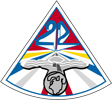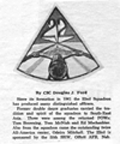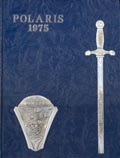Description: On a triangle, one point up, the base arched with the upper portion red and the lower in white, the Arabic numeral “22” stands out. The numeral is blue with a white base on the red field. On the white field, eight light beams in gold, blue, silver, and red radiate from the base of the numeral. The rays are surmounted by a silver gray sabre, palewise in perspective, pointing to the numeral 22. The hilt is garnished with a Navigator’s badge and the pommel with a globe. The globe shows the water areas in dark gray with the borders in black. The triangle is bordered in blue and white.
Significance: The red background is for courage. The light rays use the colors of the four classes as they converge to a point indicating the unity of purpose among all ranks of the Cadet Wing. The sabre, bearing the Navigator’s Badge and globe, represents strength and readiness.
History: This is the squadron’s original patch, adopted in 1962.
Nicknames: "Double Deuce" "Raptors"
 1965 –
1965 –













